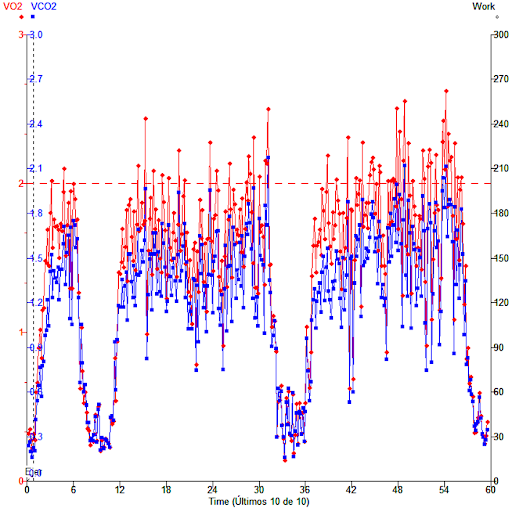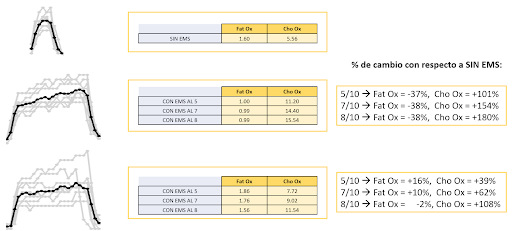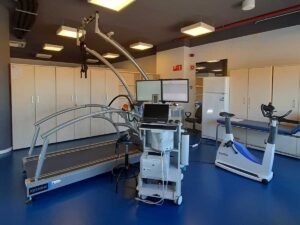In today’s post, we are going to focus on the oxidation of energy substrates and its variation with respect to a conventional cardio exercise.
It is worth mentioning that, thanks to the collaboration of the Profith group of the University of Granada, the analyzes carried out come from a gas analyzer.
What does substrate oxidation really mean?
It is important to know that an increase in the oxidation of a certain substrate does not mean that we are losing its accumulation; that is, increasing the oxidation of fatty acids is not synonymous with reducing the % fat or losing fat.
Sometimes, an increase in fat oxidation is caused by an increase in the concentration of free fatty acids in the blood, but this does not mean that we will reduce our % fat. A clear example of this is strength training, since the main energy substrate for strength training is phosphocreatine, ATP (Adenosine Triphosphate or Adenosine Triphosphate) and carbohydrate, but its performance helps improve body composition by reducing % body fat.
That said, an increase in fat oxidation can be interesting to help body recomposition; in fact, the objective of this post is to evaluate how the oxidation of substrates is modified during the application of EMS, and to analyze whether this alteration could be related to an improvement in body composition.
The study
As on previous occasions, we are going to carry out an analysis with the two frequencies used (7 Hz and 21 Hz) in the three RPEs discussed in previous posts (5/10, 7/10 and 8/10) during the exercise. low intensity in elliptical.
The study carried out at the Wiems Laboratory within the University of Granada, aimed to analyze the drift that occurs in heart rate (HR) when we use whole body global electrostimulation (WB-EMS) while performing an exercise of low intensity in elliptical of aerobic character, and placing two different electrical frequencies (7 Hz and 21 Hz).
Assessment
For the evaluation of the oxidation of substrates, the production of carbon dioxide and the consumption of oxygen are used. Through different formulas that have been mastered over time, it is possible to know the oxidation of carbohydrates and the oxidation of fats in the body. In this sense, we have used the following Frayn formula to calculate fat oxidation:
| 1.67 x volume of oxygen – 1.67 x volume of carbon dioxide |
and also Frayn’s formula for calculating carbohydrate oxidation.
| 4.55 x volume of carbon dioxide – 3.21 x volume of oxygen |
In this way we can calculate the grams per minute that have been oxidized from both energetic substrates at each moment of the test.
As we did with the energy expenditure, we have divided the analysis by crudely measured grams per minute, and the average oxidation of substrates in 5 minutes.
In order to extract data from the person’s ventilation, we have used a Medical Graphics fixed gas analyzer. The gas analyzer is capable of detecting the levels of oxygen and carbon dioxide that we consume and emit thanks to a sensor that is placed on the mask that the participant uses.
Below we present the raw result offered by the gas analyzer.
In red we have the volume of oxygen, and in blue we have the volume of carbon dioxide. For every value of oxygen there is a value of carbon dioxide. The analyzer takes into account each inspiration and expiration performed, and offers the average of all of them every 10 seconds. On this occasion, the 3 moments of exercise carried out can be clearly seen.

Study Results
The results of nutrient oxidation must be viewed with great caution, since the type of exercise, its duration, and preconditions are influential. In other words, to be able to talk about significant increases or decreases in nutrient oxidation, we should carry out prolonged exercise. We have selected 15 continuous minutes of exercise, since we consider that it is enough time to see changes in the oxidation of substrates.
On the other hand, we have previously commented that no oxidation of substrates completely predominates over the other. That is, we will never have 100% fat oxidation or 0% fat oxidation; however, with the formulas that we have previously mentioned, the results may give us something similar. In fact, it is important to relativize the oxidation of substrates out of a total of 100, thus avoiding the production of energy from other substrates such as proteins or ketone bodies.
Next, we will present a summary table of the data processed from all the participants.
Here we have the graphs of fatty acid oxidation (FatOx) and carbohydrate oxidation (ChoOx) of all the participants in gray and the average in black:

This graph represents the % oxidation of the substrate we are talking about, in one case oxidation of fats, in the other case oxidation of carbohydrates. As expected and when analyzing the heart rate data, it is logical that there is a predominance of carbohydrate oxidation. In addition, we know that carbohydrates are the main source of energy production and many times, when their reserves are depleted, that is when fat oxidation increases. That is why it is often said that to oxidize fat it is necessary to do long-term exercise, since the physiological mechanisms for “fat burning” are activated after a while. On this occasion the points appear every 5 minutes, since they are the average of the previous 5 minutes.
Regarding the analysis of the figures, it is clearly seen that the use of the second frequency results in an increase in the oxidation of fats and a reduction in the oxidation of carbohydrates. This basic physiological response can help us a lot in organizing our training, since we know that “fat burning” is optimized after 1 frequency.
“Increased intensity causes increased carbohydrate oxidation and decreased fat oxidation.”
In absolute values, we see that during the second frequency the oxidation of fats is higher at the beginning; however, if we analyze the slopes of the two curves, we see that the kinetics of nutrient oxidation are very similar. This means that the organism responds in practically the same way in both situations. This answer is totally logical since, in the two moments of the test, we went from having a 5/10 to a 7/10, and ending with an 8/ 10. The increase in intensity causes an increase in carbohydrate oxidation and a decrease in fat oxidation. However, we still don’t know if applying a second frequency at a fixed intensity will cause us to oxidize more fat than carbohydrates.
If we analyze the grams per minute that are oxidized for each energy substrate, we find that the oxidation of fats is much lower than the oxidation of carbohydrates. We also observed a reduction in CHO oxidation in the second frequency used and, therefore, an increase in fat oxidation.
In the following graph we have adjusted the oxidation of substrates so that the difference between them can be appreciated.

As with energy expenditure, we wanted to analyze the change produced in nutrient oxidation at each moment of the test. We see that fat oxidation is reduced at all times when we start using EMS. As we have commented, when there is an increase in intensity, it is normal for fat oxidation to decrease, but we are already seeing that strength training (which also reduces fat oxidation) can help reduce the percentage of fat, so the EMS are in the same line.
We also see that the decrease in fat oxidation is less during the second frequency, and even increases when its application begins. In fact, we can confirm that with the second frequency and at an intensity of 8/10, that is, with large muscle contractions, fat oxidation practically does not drop (-2%).

Conclusion
Accompanying energy expenditure data, these data are highly useful for trainers. Undoubtedly, from these data we can conclude two things:
- During the second frequency, fats are used as an energy substrate.
- Carbohydrate oxidation is highly reduced in the second frequency.
Unai Adrian Perez de Arrilucea
Wiems Lab Team







